Case studies
Industries
Resources
TikTok Collection
NEW
Table of Contents
You can spend a ton of time and money developing a new site for your business, but if it doesn’t have a high eCommerce Conversion Rate, you’ll find yourself in serious financial trouble.
And you definitely don’t want that to happen.
The good news is this:
Developing a completely new website (or making big, time-consuming changes to your existing site) isn’t the only way to increase your eCommerce conversion rate.
You can also convert more by incorporating – you guessed it – User Generated Content.
In fact, our study proves that user-generated photos are 5x more likely to create a conversion that professional product shots. Imagine how many more sales that could mean for your business!
Now, if you’re still feeling a bit skeptical about the effectiveness of User Generated Content, consider these statistics:
Ready to learn how you can use UGC to get better sales results for your business?
Keep reading, because today I’m going to walk you through exactly how it’s done. And by the time you’re finished with this post, you’ll be well-equipped to increase your eCommerce conversion rates with UGC.
Here’s a statistic that may surprise you:
Studies have shown that 92% of consumers trust recommendations from people they don’t know over branded content.
92 percent – that’s a lot. It almost makes you feel like you shouldn’t create professional content at all!
Of course, you still need professional content to create a strong brand online. But the point here is this:
When it comes to building trust with your customers in a way that helps you increase the conversion rate, UGC is the best way to go about it.
It’s easy to understand why – any business can claim to have the best product ever, so those kinds of claims have become meaningless.
But if a customer takes the time to point out a product as being the best, it actually means something.
So if you’re ready to build trust with customers, start collecting UGC (customer reviews, photos, videos, etc.) and using it to your advantage on your website and on social media.
Related reading: A guide to Consumer Generated Marketing
Want UGC to boost your eCommerce conversions? Book a demo of the Flowbox platform today to see how it can boost your results!
One of the best examples of how well this can work is Coca-Cola’s “#ShareACoke” hashtag campaign.
The Coca-Cola marketing team realized that they wanted to create a massive, disruptive campaign that made people (especially millennials) feel more connected to their brand.
After performing plenty of research, they realized that Coca-Cola was seen as out-of-touch and distant. So they realized that they needed to market their products in a way that would help them connect with customers at eye level.
And that’s exactly what they did.
Rather than running another bland advertising campaign or directly marketing their products, they created Coca-Cola products branded with popular first names.


It didn’t take long for this marketing campaign to boost US sales for the first time in over a decade and increase overall sales more than 2%. By creating an innovative, research-based campaign, they were able to get Americans to start drinking their soda again.
So, what can you learn from this campaign as an eCommerce business owner?
Mainly that it’s important for you to run branded hashtag campaigns where you encourage people to share photos of themselves with your product.
Not only is this a cost-effective way to gain UGC and spread the word about your product – it can make people feel more confident in their decision to buy from you. In other words, done right, a hashtag campaign that encourages UGC can help you increase conversions and sales.
But a branded hashtag isn’t the only way you can drive sales from social media using UGC.
Flowbox allows you to collect customer photos from across your social networks. Then, you can pick the most on-brand photos for your eCommerce business and share those photos to your own feed (after asking the customer’s permission first, of course!).
After that, all you’ve got to do is put your Shoppable Instagram link in your bio, like this:

That way, a potential customer who sees a product they like on your feed can immediately buy it.
Put yourself in a customer’s shoes for a second, and imagine you’re shopping online for bright-colored hair dye.
You just found some dye that looks awesome, and you want to make a purchase.
But you have a few pre-sales questions that you want to get answers for before you hit the “Buy” button. More specifically, you wonder:
And UGC can answer all of those questions for you.
As the customer, you wouldn’t have to put time and effort into calling or emailing the company to find out what you need to know – you could simply hop on social media and see how other people were using their hair dye.
For example, here’s UGC that’s been re-posted to Instagram by the hair dye brand Arctic Fox Hair Color:
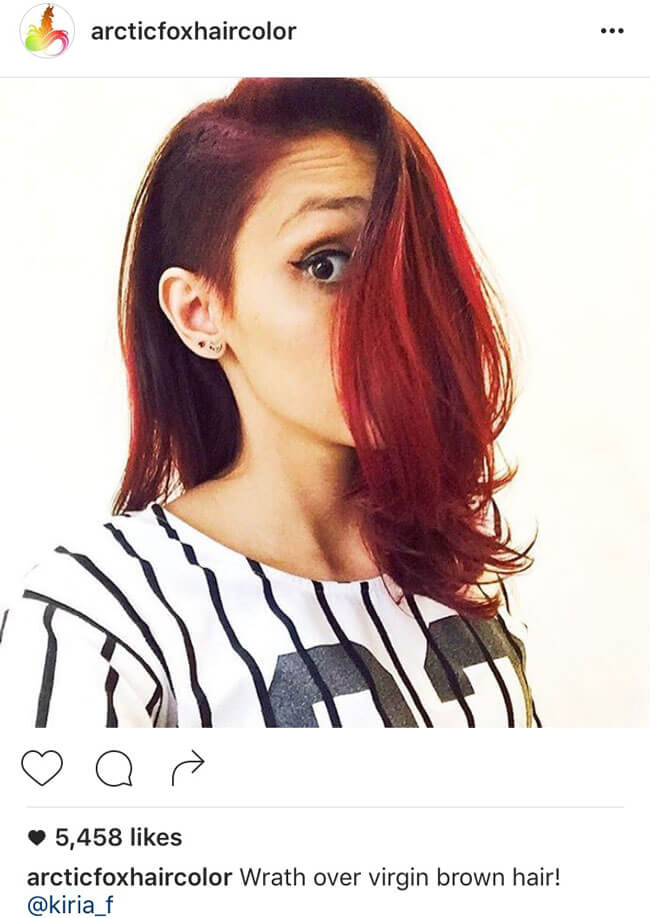
The caption explains that the customer has used the hair color “Wrath” (a red color sold by Arctic Fox) over virgin brown hair. In other words, this person is a natural brunette who has never dyed her hair before, and she applied the dye directly to her hair without bleaching first.
Why does that matter so much?
Because it shows customers exactly what they can expect if they plan to use the product in a similar way.
Trust me – your customers want to research your brand before they make a purchase, and if you can provide them UGC that helps, they’ll be much more likely to buy.
I know this not only because of the research that supports it, but also because I have bright fuchsia hair, and I’ve personally used UGC to help me make a hair dye purchasing decision before. So you’re reading about a real experience straight from an eCommerce customer right now!
Another way UGC helps answer pre-sales questions?
Reviews and testimonials.
For example, look at this review of an eyeliner available on the Kat Von D Beauty website:

You can see that the reviewer has answered these pre-sales questions here:
When customers see the review, they no longer have to wonder if the eyeliner works well – they know that it does because they’ve heard it from a real customer.
So by giving answers to these questions, the reviewer helps Kat Von D’s potential customers overcome objections (“I’m worried this eyeliner won’t last all day, so I’m not going to buy it!”) and therefore increase conversions and sales.
I touched on this in the hair dye example above a bit, but let’s look at another example too.
Eclectic Eccentricity is an eCommerce store full of unique jewelry, and they share lots of styled photos on Instagram, like these:

While these photos are creative and help them build a strong brand, they don’t quite show what the jewelry looks like when worn.
So, they make sure to share plenty of UGC on Instagram for that purpose.
Here’s a customer photo they’ve used to showcase a ring and a locket that they sell:
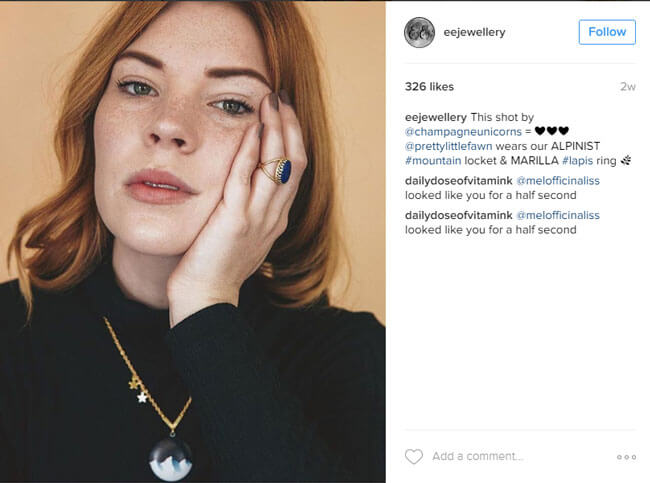
You can see that the picture immediately helps customers understand what the jewelry actually looks like when worn.
But what if your product can’t be worn?
Simple:
Show what it’s like to use your product.
Witch Baby Soap is a popular bath product brand, and they do a great job of this on Instagram.
They don’t just post fancy photos of their soaps and bath bombs – they show what the actual experience is like for customers using those products! Here’s an example:
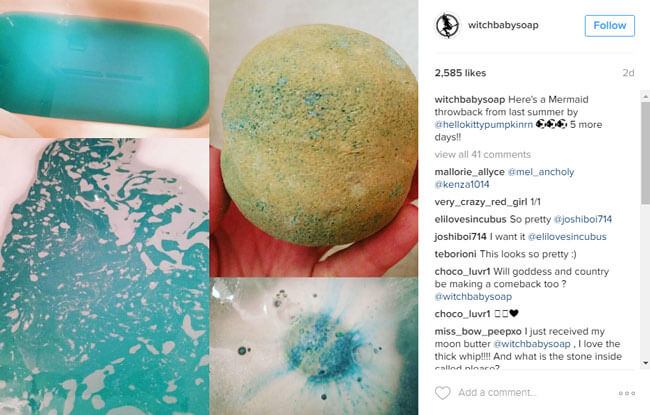
They share customer videos too, like this video of a customer using a bath bomb in their bathtub:

The point here is to use UGC to help customers envision themselves wearing (or using) the product you’re selling, which can go a long way in convincing them to make a purchase.
You’ll still want to use your own photos on Instagram and your other social media sites to help build your brand image, but don’t neglect UGC in the process – it can go a long way in making your potential customers choose to buy from your business instead of one of your competitors!
Data shows that UGC can increase click-through rates for Facebook ads by 300%, resulting in a 50% drop in cost-per-acquisition.
Pretty impressive, right?
That statistic alone probably has you interested in using UGC soon for your eCommerce business. So, let’s look at how you can do it in your Facebook and Instagram ads.
Here’s an example of an ad of Facebook from Perfect Locks that uses UGC effectively:
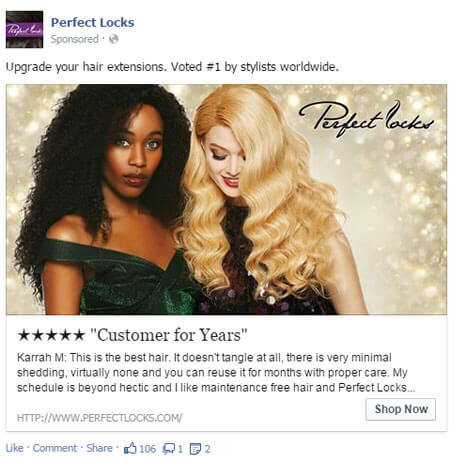
On top of the 5-star rating, they’ve got a name and review from a real customer. On top of that, the ad mentions that the extensions have been voted #1 by stylists worldwide.
All of those aspects of the ad come together to make a strong case for the company’s product.
Now, let’s look at an example of an Instagram ad that uses UGC the right way.
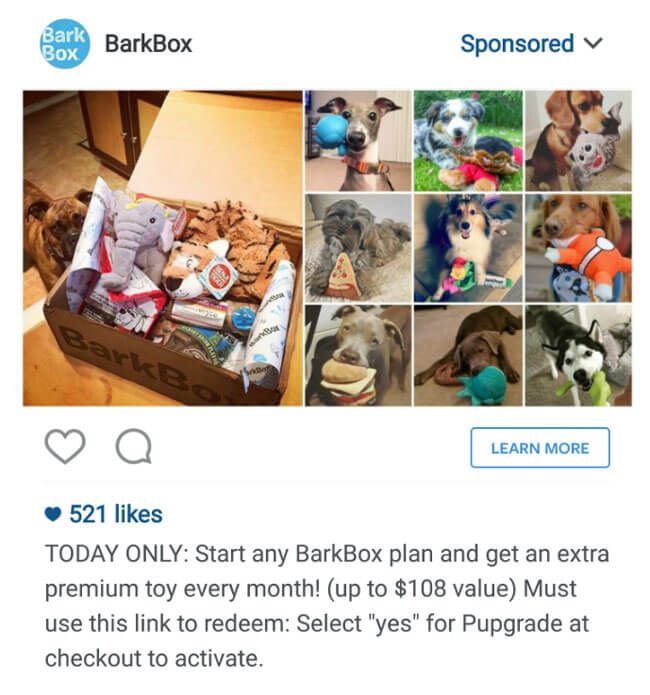
BarkBox isn’t using any written customer reviews here, but they don’t really need to do that. They’ve got photos from happy customers to use in their ads, and that’s enough to convince more people to purchase their product.
So, keep these 2 approaches to ads in mind when you’re planning your next social media advertising campaign, and don’t be afraid to throw in a customer review or photo (or both!).
By now, you understand how UGC can help drive traffic to your eCommerce website.
But the important thing is this:
That traffic isn’t just any traffic. It’s relevant traffic – people who are likely to be interested in purchasing your products.
Think about it. If you use other marketing methods, you may waste money reaching all kinds of people outside of your target audience.
But if you use UGC correctly, you can put your products directly in front of your target audience.
Not only that – since UGC is trusted more than branded content, you can feel confident knowing that your target audience will be more likely to make a purchase from your eCommerce store.
And that brings me to my next point.
For eCommerce marketers, closing sales doesn’t involve talking on the phone with customers. It involves sharing enough information with customers to make them feel good about the purchase they want to make.
If you do it right, your UGC will help potential customers overcome their objections to buying your product.
So if you’ve got an eCommerce business and you’re not using UGC to promote your products, now is the time to start.
Not only will you be able to increase conversion rates – you’ll be able to build a strong brand and connect with your customers in a way that sets your business up for long-term success.
Do you have any questions about using UGC? Let’s talk about it in the comments section below!